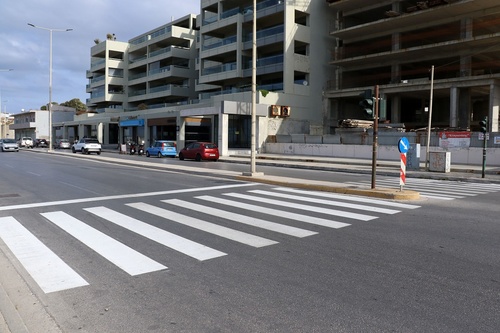Mobility and transportation
HERAKLION SUSTAINABLE URBAN MOBILITY STRATEGY
Heraklion aims to be transformed into a sustainable, accessible and truly smart city in mobility terms. It will be a city not based solely on the automobile, but a place that promotes, walking, cycling, collective and shared transportation through a functional network with well aware and informed commuters.
The Strategy on Smart Urban Mobility consists of 9 sub-sections (following the SUMP strategy pillars): Walking, Bicycle, Collective Transportation, Traffic Management and Private Vehicle Circulation, Speed Management and Road Safety, Innovative Means of Transport & Shared City Concept, Clean Vehicles, Logistics & Supply Management and Education-Communication-Awareness.
Ι- Walking
Walking is the most free and independent way of traveling around the city. It allows the pedestrian to enjoy the city as well as to interact with other users in the public space. Walking has also significant health benefits. New technologies and common traditional techniques will contribute significantly to several actions in promoting walking as a commuting mode in Heraklion.
The main areas of action on WALKING include the following;
Innovative actions
– Pilot testing and installation of special ICT urban equipment (signs, benches, lighting, shelters, stops, information and/ or sale kiosks etc.),
– Development of systems to measure pedestrian flows and identify the geography and patterns of most used routes,
– Installation of Smart and Accessible Bus stops and Taxi stops,
– Electronic accessibility rehabilitation of the transport system for disabled people as well as other vulnerable users (i.e. ticket issuing) ,
– Upgrade of the existing municipal APP or new Application development for crowdsourcing data collection while walking in the city (incl. existing functions such as problem reporting, points of interest etc).
Core actions
– Improvement of sidewalks and pedestrian crossings in the context of the contemporary legislation and the urban mobility principles (with particular emphasis on the city center and city’s main arterial roads)
– Improvement of junctions facing inadequate road safety features, particularly on areas around school complexes and areas with increased pedestrian flow,
– Development of traffic calmed roads and traffic calming areas (e.g. in central neighborhoods such as Agia Triada, Lakkos etc., and in suburban neighbourhoods like Mastabas, Agios Ioannis, Mesambelies etc.),
– Development of Pilot Urban Mobility Neighborhoods (one per municipal unit),
– Upgrade of the existing green routes and development of an Eco-Cultural Network along significant routes- streets such as the Knossos Boulevard, Nearchou-Venizelou Street (Seafront), Machis Kritis, Ikarou, Papandreou, Therisou, A. Papandreou etc.),
– Development of accessible thematic routes (i.e. Culture Route, Shopping Route etc.),
– Special provisions for each different disability category (e.g. different requirements for blind people, people with reduced mobility etc.),
– Improvement of accessibility in Public Transport Stops and taxi stops and enhancement of multimodality between pedestrian-PT system, cyclists’ -PT system (bicycle dragging), pedestrian-cyclist, private vehicle-PT, private vehicle-cyclist etc. (e.g. on the main city gates, crucial junctions etc.)
IΙ- Cycling
Cycling has similar benefits to walking, but can be easily used for long-distance travels. Over the last few decades, Cycling has been integrated in formal urban and traffic plans in a multitude of cities, enabling it to become a major commuting mode. Heraklion aims to welcome cycling through a number of actions including tools enabling new technologies.
The main areas of action on CYCLING include the following.
Innovative Actions
– Upgrading of the existing bike sharing system for citizens (residents and visitors) with a 24/7 dock less system and electronic application support,
– Installation of an electronic system for dispensing shared bikes to citizens (residents and visitors) with 24/7 lending system and electronic application support either from specific delivery and receipt points (dockless with designated parking lot) either completely dockless,
– Research on the utilization of electric scooters and segways as last mile alternative commuting modes,
– Use of environmentally friendly electric bicycles (in passenger and freight transport),
– Development of a smart bike flow measurement system to identify the geography of the most frequently selected routes,
– Development of an application with various data (or enhancement of existing apps) aiming at a readable and complete navigation system for cyclists.
Core Actions
– Development of a complete cycling network (cycle lanes, cycle corridors and mixed use streets) as well as bicycle parking stations,
– Improvement of crossings with emphasis on the safe passage of pedestrians and cyclists (especially in intersections such as Geronimaki-Dimokratias, Ikarou-Bofeur- Eleftherias Square, 62 Martyron, Panagiotaki, Christomichali Xilouri-Ai Yanni Hostou, Ierolochiton-Atlantidos, Papapetrou Gavala- Ethnomartyron, Papanastasiou, etc.),
– Promotion of public spaces and network integration for pedestrians and cyclists,
– Improvement of accessibility in Public Transport Stops and taxi stops and enhancement of multimodality between pedestrian-PT system, cyclists-PT system (bicycle dragging), pedestrian-cyclist, private vehicle-PT, private vehicle-cyclist etc. (e.g. on the main city gates, crucial junctions etc.)
ΙΙΙ- Collective Transportation
Public transport should be the backbone of the city’s transport infrastructure. The benefits to residents and visitors vary, with the most important being road safety, sociability and economic efficiency. It is therefore necessary to actively promote it in every possible way. New and smart technologies can contribute notably to this objective for the city of Heraklion, enhancing both its efficiency and attractiveness.
The main areas of action on COLLECTIVE TRANSPORTATION include the following.
Innovative Actions
– Research on the feasibility of developing a Light Rail Transit Network,
– Utilization of clean electric buses and smaller vehicles with emphasis on routes serving the most congested areas (for example city center, University, Airport, Knossos, etc.),
– Improvement of the installation of telematics system for passengers’ information and interfacing through DIMOTIS application for remote information,
– Construction of (electronic) accessible infrastructure for people with disabilities and vulnerable citizens’ groups,
– Research on the potential integration of a single electronic ticket for bus and taxi (and bus-tram in the future),
– Development of efficient public transport management technologies,
– Sensor installation on Public transport vehicles in order to enhance traffic and pollution monitoring in the urban area of Heraklion,
– Installation of smart bus stops.
Core Actions
– Reorganization of existing routes and development of new Public Transport connections,
– Installation of new accessible stops and stations, upgrading of existing stops and reallocation of the Taxi stations in order to serve complementary to public transport network,
– Enhancement of multimodality for better service of the system pedestrian-public transport, cyclist-public transport (bicycle dragging), taxi-pedestrian, taxi-public transport, taxi-cyclist, etc.),
– Provision of exclusive road space for public transport (e.g. bus lanes in arterial roads like the coastal avenue, Petaloeidis, Dimokratias, Knossou, Ikarou, Kazantzidi, Antistaseos, Pitsoulaki, etc.),
– Development of Park & Ride Infrastructure at the outskirts of the city,
– Route enhancement, necessary route changes and development of a strategy to tackle seasonal variation of demand due to tourism activities through smart integration of Taxi and Public Transport.
ΙV- Traffic Management and Private Vehicle Circulation
Private car is not only the leading factor in creating traffic congestion in cities, triggering traffic incidents, but also one of the most important causes of air pollution, Greenhouse effect and, in general, urban degradation. The motorcycle also operates towards the same direction; however it occupies significantly less space. It is therefore urgent to severely limit their dominance and improve their circulation in certain sectors. Heraklion works towards limiting through traffic by implementing several policies especially in the city center. New technologies can play an important role towards this direction.
The main areas of action on TRAFFIC MANAGEMENT AND PRIVATE VEHICLE CIRCULATION include the following.
Innovative Actions
– Development of a system for traffic data collection and provision of real-time navigation information,
– Variable message system (VMS) installation,
– Development of a smart system for controlling short-term parking and variable parking spaces in the city center and the densely populated suburbs or neighborhoods of the city,
– Development of a smart system for preventing illegal parking at predetermined points (i.e. pedestrian crossings),
– Development of a navigation and parking assistant application for mobile phones aiming at the prevention of unnecessary parking searching,
– Improvement of traffic management with smart signaling,
– Import of electric vehicles and their charging points at central places of the city,
– Establishment of a connected vehicle management center in order to improve road safety and efficiency.
Core Actions
– Road Network Classification and relevant policies,
– Development of traffic calmed areas in combination with prevention of through traffic in neighborhoods,
– Development of car-free areas,
– Permanent or Temporary Interventions in order to prevent illegal parking,
– Improvement of mobility conditions around school complexes by creating mobility plans to promote alternative modes of transport -school mobility plans (e.g. walking/ cycling bus, carpooling),
– Improvement of mobility in organizations through the creation of mobility plans- work travel plans (e.g. Commuters to the University Hospital of Heraklion, University, Companies located in the Industrial Area etc.)
– Development of Park & Ride Infrastructure at the outskirts of the city.
V- Speed Management and Road Safety
Speed is one of the most important operating factors of an area’s road network. High speed road networks are creating conditions of increased risk, resulting in more traffic accidents. Speed, as well as other elements of the network or its users (geometric configuration, traffic signs, driving behavior, vehicles, road condition, etc.), influence the level of road safety in an area. New technologies combining traditional practices have the potential to improve the level of road safety with a variety of actions in Heraklion.
The main areas of action on TRAFFIC MANAGEMENT AND ROAD SAFETY include the following.
Innovative Actions
– Development of a Municipal Traffic Centre for Monitoring and Informing the citizens and decision makers in real -time,
– Development of a system for traffic data collection and provision of real-time navigation information,
– Combination of ICT tools for monitoring of environmental and traffic issues,
– Implementation of innovative ways for traffic monitoring and road maintenance (identification and improvement of dangerous points and systematic monitoring of driving behavior),
– Variable message system (VMS) installation in order to inform and warn drivers for speed limits, real-time network situation, etc.
Core Actions
– Reduction of speed limits across the city at 40km/h and in the neighborhoods from 20 to 30km/h (in combination with case specific traffic calming interventions at crucial sites such as schools),
– Traffic calming measures for enhancing vulnerable users’ accessibility,
– Redesign of junctions for road safety in key spots,
– Redesign of traffic signs in conjunction with restrictions for through- traffic.
VΙ- Innovative Means of Transport & the Shared City Concept
The need to create sustainable, social and functional cities requires a shift to innovative modes of transport, which will be shared and allow public and collective use. This shift will lead to space and costs savings and will create the appropriate conditions for greater social interaction. New technologies can play a fundamental role in the introduction of such modes of transport in the city of Heraklion.
The main areas of action on INNOVATIVE MEANS OF TRANSPORT & SHARED CITY CONCEPT section include the following.
Innovative Actions
– Upgrading of the existing bike sharing system for citizens (residents and visitors) with a 24/7 dockless system and electronic application support,
– Installation of a new electronic system for dispensing 200 more shared e-bikes to citizens (residents and visitors) with automatic lending and support from an electronic application either from specific delivery and receipt points (dockless with designated parking lot) either completely dockless,
– Research on the utilization of electric scooters and segways (dockless or not) as an alternative last-mile commuting mode,
– Integration of mini/ midi buses into the Public Transport System for developing on-demand services,
– Research on the introduction of financial or other incentives for the enhancement of collective and shared modes of transport,
– Support of private initiatives regarding car sharing.
VΙΙ- Clean Vehicles & E- Mobility
Emissions from conventional motor vehicles are considered the most serious drivers of greenhouse gas emissions, pollution etc., while the noise they produce generates significant nuisances in the urban environment and quality of life. Therefore, the shift to new clean vehicles is considered imperative and Heraklion aims to be at the forefront of such transformation.
The main areas of action on CLEAN VEHICLES include the following.
Innovative Actions
– Promotion of gradual replacement of municipal vehicles’ fleet (e.g. garbage truck, school buses etc.) with clean vehicles,
– Promotion of gradual replacement of public transport vehicles’ fleet with clean vehicles,
– Installation of a functional e-mobility charging network,
– Research on the introduction of financial or other incentives for the integration of E-mobility in organizations & companies with large vehicle fleets.
VΙΙΙ – Logistics & Supply Management
Logistics and supply management is now seen as a key sector of any urban mobility strategy. Daily commodities and goods transportation can operate in a system, not just by obeying common travel rules, but by working towards a common vision for the city and an integrated distribution process avoiding excess driving and combining travels.
The main areas of action on LOGISTICS & SUPPLY MANAGEMENT include the following.
Innovative Actions
– Support of gradual implementation of cooperative transport systems in freight transportation,
– Promotion of the gradual replacement of conventional supply vehicles (trucks and motorcycles) with green and shared vehicles,
– Combined management of supply chain activities and parking policies.
Core Actions
– Development of Sustainable Urban Logistic Plan (SULP)
ΙX- Education-Communication-Awareness Raising
Substantial change in urban transportation and mobility behavior will not be managed if there is no change in citizens’ attitude and everyday choices. Communication and Awareness Raising actions regarding sustainable modes of transport are particularly important parameters for implementing any smart urban mobility strategy as they define the actual context of the needed change in mobility behavior from city residents and visitors.
The main areas of action on EDUCATION-COMMUNICATION-AWARENESS include the following.
Innovative Actions
– Development of awareness raising campaigns for the role of technology in urban transportation and mobility,
– Workshops aiming at familiarizing travelers in participatory planning and the use of crowdsourcing applications.
Core Actions
– Information and awareness raising actions and campaigns on issues of transportation, urban mobility, accessibility and parking,
– Combined informative actions for children and the elderly (emphasis on target groups: children, elderly people, people with disabilities, etc.) on issues of mobility choices and road safety.
This comprehensive strategy requires systematic and thorough monitoring and assessment. This monitoring is carried out through various sets of indicators which are distinct and readable, clearly reflecting the implementation of the Municipal strategy.
Check our City Dashboard to explore several datasets and indicators.







